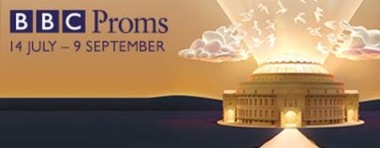
 United Kingdom 2017 BBC PROMS 33 – Sibelius, Grieg, Schumann and Hindemith: Lise Davidsen (soprano), Alban Gerhardt (cello), BBC Philharmonic Orchestra / John Storgårds (conductor), Royal Albert Hall, London, 10.8.2017. (AS)
United Kingdom 2017 BBC PROMS 33 – Sibelius, Grieg, Schumann and Hindemith: Lise Davidsen (soprano), Alban Gerhardt (cello), BBC Philharmonic Orchestra / John Storgårds (conductor), Royal Albert Hall, London, 10.8.2017. (AS)
Grieg – Peer Gynt, Op. 23 – excerpts
Sibelius – Luonnotar, Op. 70; Karelia Suite
Schumann – Cello Concerto in A minor, Op. 129
Hindemith – Mathis der Maler – Symphony
Looking back at previous Prom performances of Peer Gynt, David Gutman’s note in the programme observed that even the once popular Suite No. 1 has “latterly almost disappeared from view, along with so many of the suites, overtures and short orchestral pieces that once dominated the lists”. Yes, indeed, and this seems a matter of regret. Do we always want to be listening to long, serious symphonies, expansive and complex tone poems, large-scale choral works and challenging contemporary works? Not quite so much, I would suggest.
These thoughts occurred as I listened to the five exquisitely wrought excerpts from Grieg’s music for Ibsen’s play. How haunting are the wistful, grave beauties of “Ingrid’s Lament”, “Morning Mood” and “Solveig’s Song”. The two other excerpts played, the Prelude to Act 1 and “Dance of the Mountain King’s Daughter” show a more energetic Grieg, the latter a good sample of the imaginatively grotesque nature of elements in the complete score. All were played with superb style and atmosphere by the BBCPO under Storgårds. In the first verse of “Solveig’s Song”, the soprano soloist, Lise Davidsen, making her Prom debut, sounded a little out of sorts, but the second verse was nicely sung.
Sibelius’s Luonnotar, a setting of a segment of the Finnish national folk epic, Kalevala, features some strange happenings involving the Daughter of the Air, named in the work’s title. It sounds like a challenging role for the solo soprano, and Lise Davidsen did pretty well in coping with the complexities of Sibelius’s strange, unworldly music. The Karelia Suite, with its friendly, jaunty outer movements and lyrical central “Ballade”, made a strong contrast in Sibelian approachability, and was conducted by Storgårds with a good deal of cheerful energy.
More serious fare awaited listeners in the second half. Schumann’s Cello Concerto was a favourite work of Jacqueline du Pré, who played its dark ruminations with romantic ardour. Alban Gerhardt’s approach was still lyrical, but more urgently expressive and quicker in tempi. The central Langsam movement was certainly not “Slow” as the score directs, which perhaps made for insufficient contrast with what had gone before. But the last section of this three-in-one movement work was projected with defiant vigour, and like the rest of the work, was played with impressive tone and technique by the soloist, with Storgårds an attentive, responsive partner.
Hindemith’s music, alas, has never recovered from its neglect since the composer’s death in 1963. We did hear a performance of his Nobilissima Visione Suite at the Royal Festival Hall as recently as last April, but usually he rarely features in concert or recital programmes. It was therefore brave of Storgårds to feature his best-known work, the Mathis der Maler Symphony, as the concluding item of the concert, rather than shelter it somewhere in the middle. We heard a finely played, confident account of the work by Storgårds and the BBCPO, the opening “Angel Concert” played perhaps a little too quickly to convey entirely its mystical, devotional quality. But the quiet central movement was appropriately hushed and intense, and the final movement’s depiction of St Anthony’s suffering at the hands of the Devil’s surrogates, with his eventual triumphant release, was strongly characterised, the final ecstatic climax conveyed in gratifyingly whole-hearted fashion.
Alan Sanders
For more about the BBC Proms visit https://www.bbc.co.uk/proms.

Thanks for this lovely review, Alan, and you are absolutely right, du Pré is the best and unreached, but if you allow me to correct you in one point: the score does suggest “Langsam” (slow) for the middle part of the concerto while putting the metronome marking of 63 which is incredibly fluent (last night we probably were at 55 max, most performances are indeed even slower). While I absolutely don’t claim to know the truth, I have the idea that Schumann put these metronome markings while singing the tune maybe out loud or maybe even playing it on the piano, and then 63 makes perfect sense, it’s like a beautiful song. The cellists challenge now lies in trying to come as close to what Schumann had in mind without it sounding mechanical or breathless. Obviously it didn’t totally convince you last night, but I must admit I am not really thinking of the second movement being of total contrast to the first – it is a beautiful story being told in different episodes, but still the same story. Sorry for this long entry, but it’s a subject I feel passionate about ?
Dear Alban,
Thank you for your kind response.
I didn’t mean to imply that du Pré was “best and unreachable”; only that her performance was different from yours, which has its own very special merits.
I take your point about the slow movement: it’s just that one is used to hearing it in a more lingering fashion. But fashions (in a different sense) can change and one hopes that performers will in future strive to match the composer’s original conception of the movement.
This is more difficult for cellists than pianists, who have the recordings of Fanny Davies and Adelina de Lara as authoritative guides to Schumann’s performing intentions.
Best wishes,
Alan Sanders